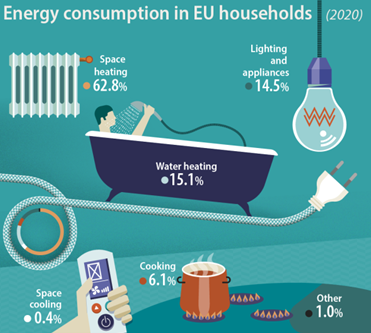Heating and Cooling
ENERGY EFFICIENCY
Introduction
Space and water heating as well as cooling accounts for roughly 45% of the European final energy consumption. Despite recent efforts to introduce more renewable energy sources in the heating and cooling sector, around 75% of the fuel consumed still stems from non-renewable sources (ca. 50% from gas).
Description
Space heating and cooling makes up a considerable share of the total energy consumption in buildings across the European Union today. Whereas space heating accounts for more than 80% of the total heating and cooling consumption in colder climates, space cooling is the most important factor in warmer climates such as southern Europe. Buildings frequently lose heat or cold due to poor quality. Circa 70% of the EU’s building stock was built when energy efficiency requirements were very limited or non-existent, thus, their renovation is essential.
The affordability of heating and cooling can be understood as the ability of households to pay the energy cost necessary to keep their homes adequately warm in winter or cool in summer. As a reference, the cost of space and water heating across the EU represents on average 6.4% of total household expenditure, ranging from only 3% in Malta to a staggering 16% in Slovakia. The cost of heating varies widely across households in Europe as it heavily depends on individual factors such as the energy efficiency of the premises, the fuel type and technology used to heat and cool, the price of energy per unit, and the individual needs and living conditions of the occupants.
Replacing fossil fuels such as oil or gas with renewable energy sources and other zero-carbon solutions in the heating and cooling sector has not gained the same thrust as in the electricity sector where the use of wind or solar for electricity generation is today more widely available. In the heating and cooling sector renewables currently provide only 23% of the total consumption.

Main Features
- A big proportion of the energy bill is dedicated to space heating.
- Energy poor households are at a higher risk of suffering from temperature related mortality, mental health issues and social isolation.
- Adverse impacts on health are also widespread as a result of heat waves during summer.

Image source: Eurostat
Advantages and challenges
+ Energy efficient buildings can result in net zero utility bills.
+ Considerable energy savings can be made through simple renovations such as insulating walls, foundations, attic, installing double/ triple glazing.
+ Nature-based solutions, e.g., trees, green roofs and walls providing insulation and shade to buildings reduce demand for heating and cooling.
+ Building or renovating a home in an energy efficient manner is usually costlier up front, although some costs can be recovered through tax credits, energy savings, and other financial incentives.
– Lack of awareness of the benefits of energy saving, lack of professional advice on technical aspects and financing are the most prominent constraints for homeowners to renovate/modernise.
– Energy efficiency investments are less attractive in multi-apartment buildings due to split ownership. They can be also challenging in case of rented buildings due to tenancy rules and the fact that property owners have little incentive to invest if the tenant pays the energy bill.


